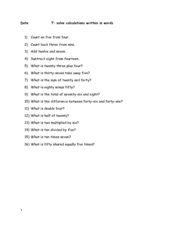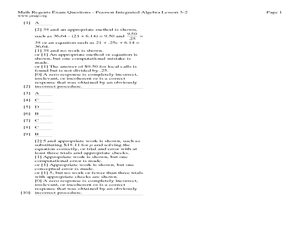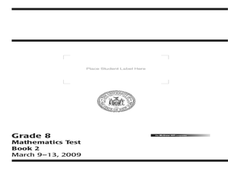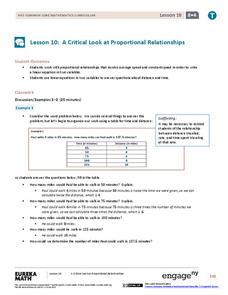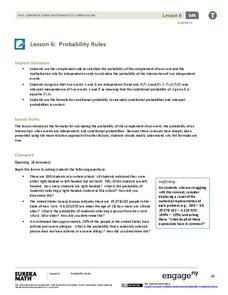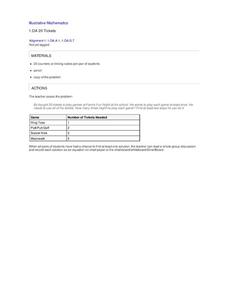Curated OER
Partial Products
Students use the partial products algorithm to complete multiplication problems. In this partial products lesson plan, students are introduced to the algorithm and connect the relationship to multiplication and division problems.
Curated OER
Mathematical Modeling and constant Rate Equations
In this rates learning exercise, students solve five story (word) problems related to rate and time. In two of the problems students are directed to create a graph of the problem.
Curated OER
Chapter 10 - Objective 1.1 - Square Roots
In this square root worksheet, students solve simple square roots and square roots containing exponents. Students use factoring and the distributive property under the square root prior to solving. This one-page worksheet contains ten...
Curated OER
Chapter 10 - Objective 2.1 - Square Roots
In this square root activity, learners add and subtract square roots. Square roots contain exponents and one to two variables. This one-page activity contains ten problems.
Curated OER
Solve Calculations Written in Words
In this math words worksheet, students solve 16 problems in which math sentences in words are translated into numbers and operations. Students solve the mixed operations number sentences.
Curated OER
Solving Multiple-Step Problems
Students solve 2-step word problems. In this word problems lesson, students are shown examples of word problems and solutions on the board by the teacher. Then they complete a six problem worksheet independently.
Curated OER
Mathematical Roadmaps
Second graders observe how a sample math problem is solved on the overhead. They work in small groups to develop a strategy for solving another problem using counters as well as a large sheet of paper to write down their explanation of...
Curated OER
Math Regents Exam Questions: Solving Multi-Step Equations
In this solving equations worksheet, high schoolers solve 10 multiple choice and word problem equations. Students use the distributive property to combine like terms and isolate the variable.
Curated OER
Problem Solving Techniques
Learners develop a pattern for problem solving. They gain confidence in their ability to solve problems and are introduced to mathematics help online.
Curated OER
New York State Testing Program Grade 8 Math Sample Test 2005
In this New York state sample test worksheet, 8th graders solve thirty-three sample math problems designed to help students prepare for the grade eight math test. Tips for taking the test are provided.
Curated OER
Choose the Operation
In this mathematical operations worksheet, students solve the six math word problems by determining which operation to use, addition or subtraction, to solve the problem.
Curated OER
New York State Testing Program Math Release questions grade 8
In this algebra and geometry worksheet, students solve seven varying math problems. This worksheet will help prepare students for standardized tests covering algebra and geometry.
Curated OER
Division Problems with 0 and 1
Students explore beginning division. In this division number properties instructional activity, students solve simple division story problems using cookies. Students create models that represent the identity and zero properties, then...
Inside Mathematics
Number Towers
Number towers use addition or multiplication to ensure each level is equal. While this is common in factoring, it is often not used with algebraic equations. Solving these six questions relies on problem solving skills and being able to...
Education Development Center
Distance, Rate, and Time—Walking Home
Dig into a classic math problem with your classes. Through an engaging task, learners work with rate and distance information to make conclusions. In the task, two people walk at different rates; one leaves first, and scholars calculate...
Utah Education Network (UEN)
Real World Equations and Inequalities
Use of the resource = Opportunities for increased learning. Learners must use equations and inequalities to solve real-world and geometric problems.
EngageNY
A Critical Look at Proportional Relationships
Use proportions to determine the travel distance in a given amount of time. The 10th installment in a series of 33 uses tables and descriptions to determine a person's constant speed. Using the constant speed, pupils write a linear...
EngageNY
Normal Distributions (part 1)
Don't allow your pupils to become outliers! As learners examine normal distributions by calculating z-scores, they compare outcomes by analyzing the z-scores for each.
Illustrative Mathematics
How Many Colored Pencils?
Support young mathematicians' interpretation of place value in order to multiply single-digit numbers by 10. The task builds upon and enhances a learners' understanding of place value, a second grade skill, while introducing them to...
EngageNY
Probability Rules (part 1)
In statistics, probability rules—literally! Learners use their previous knowledge and explore a set of rules for conditional probability, independent probability, and complements. Given different scenarios, they must determine what type...
EngageNY
Chance Experiments with Equally Likely Outcomes
Take a deeper dive into equally likely probabilities. Pupils build upon their understanding of probability by determining sample spaces and outcomes. Individuals work with sample spaces and determine outcomes that are equally likely....
EngageNY
Chance Experiments with Outcomes That Are Not Equally Likely
The fifth portion of the 25-part series introduces probabilities calculated from outcomes that are not equally likely. Class members use tables to calculate probabilities of events, add outcome's probabilities, and find complements....
Curated OER
20 Tickets
A great hands-on activity involving adding and subtracting, beginner mathematicians determine how many games can be played with 20 tickets. Instead of tickets, youngsters use 20 counters or linking cubes to represent the amount of...
Curated OER
How Fast is it Traveling?
Learners calculate the rate of speed of various moving objects within the classroom setting, or outside under a controlled environment.






